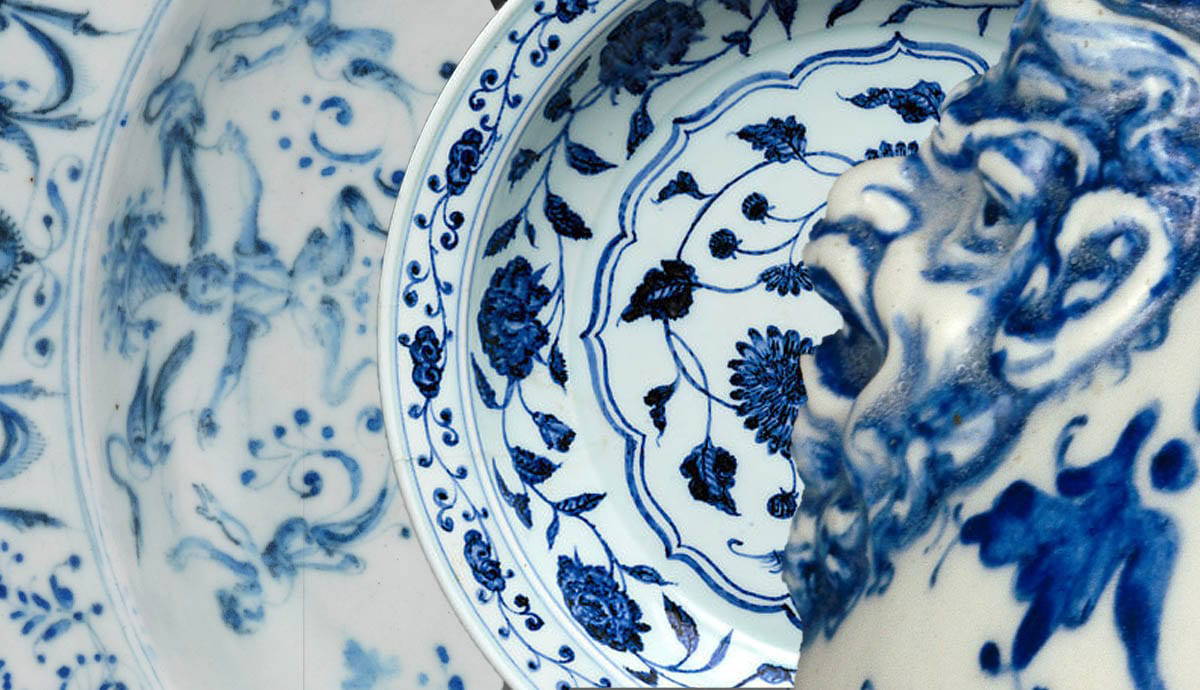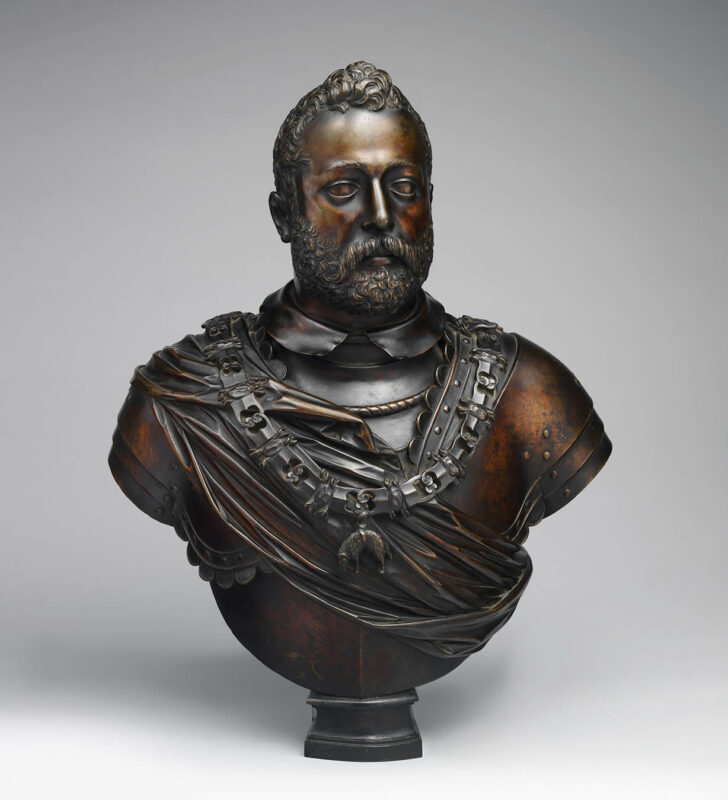
Chinese porcelain has long been considered a great treasure. From the late 13th century it began appearing in the courts of Europe as trade routes expanded. By the second half of the 15th century, Chinese porcelain was plentiful in the ports of Turkey, Egypt, and Spain. The Portuguese began importing it systematically in the 16th century after founding a post at Macao.
Due to Chinese porcelain’s value, there was a desire to replicate it. Attempts at replication were difficult and resulted in concoctions of ingredients and firing times that did not produce the ‘hard-paste’ porcelain of China, or anything similar.
Finally, in the last quarter of the 16th century, the Medici factories in Florence produced the first European porcelain – the Medici ‘soft-paste’ porcelain. While it emulated Chinese porcelain, the soft-paste porcelain was a wholly novel creation by the Medici family.
History: Importing Chinese Porcelain

Get the latest articles delivered to your inbox
Sign up to our Free Weekly Newsletter
Porcelain had been made in China since the 7th century and was manufactured with very specific ingredients and measures, resulting in what we now call ‘hard-paste’ porcelain. Italian explorer Marco Polo (1254-1324) is credited with bringing Chinese porcelain to Europe in the late 13th century.
To European eyes, hard-paste porcelain was a vision to behold – beautifully and vividly decorated, pure white ceramic (often referred to as ‘ivory white’ or ‘milk white’), smooth and unblemished surfaces, hard to the touch yet delicate. Some believed it had mystical powers. This extraordinary commodity was avidly acquired by royalty and wealthy collectors.

The Ming Dynasty (1365-1644) produced the distinctive blue-and-white porcelain known to enthusiasts today. Hard-paste Chinese porcelain’s main components are kaolin and petuntse (which produced the pure white color), and the wares are painted under a transparent glaze with cobalt oxide which gives a rich blue color after firing at 1290 C. By the 16th century, the designs seen on Chinese hard-paste porcelain included multi-colored scenes using complementary colors – the ubiquitous blue, and also red, yellow, and green. Designs portrayed stylized flowers, grapes, waves, lotus scrolls, vine scrolls, reeds, fruit sprays, trees, animals, landscapes, and mythical creatures. The most well-known Ming design is the blue-and-white scheme which dominated Chinese ceramic works from the early 14th century to the late 1700s. Typical vessels produced in China include vases, bowls, ewers, jars, cups, plates, and various objets d’art like brush holders, ink stones, lidded boxes, and incense burners.

During this time, Italy was undergoing a Renaissance, producing great masters, techniques, and imagery. Painting, sculpture, and the decorative arts were conquered by Italian artists. The master craftsmen and artists of Italy (and Europe) eagerly embraced the far Eastern designs that had been making their way through the continent for over a century. They were inspired by Eastern artistic practices and products, the latter of which can be seen featured in many Renaissance paintings. After 1530, Chinese motifs were seen frequently in maiolica, Italian tin-glazed earthenware that exhibited a variety of ornament. Also, many pieces of maiolica were decorated in the istoriato style, which is storytelling through visuals. This artistic approach was an adoption of far Eastern means of expression.

The pursuit to replicate Chinese porcelain preceded Francesco de’ Medici. In his 1568 edition of The Lives of the Most Excellent Painters, Sculptors, and Architects Giorgio Vasari reports that Bernardo Buontalenti (1531-1608) was trying to figure out the mysteries of Chinese porcelain, however, there is no documentation to state his findings. Buontalenti, a stage designer, architect, theatrical designer, military engineer, and artist, was in the employ of the Medici family for his entire career. How he influenced Francesco de’ Medici’s porcelain quest is unknown, if at all.
Emergence Of Medici Family Porcelain

By the mid-16th century, the Medici family, great patrons of art and prominent in Florence from the 13th to the 17th centuries, politically, socially, and economically, owned hundreds of pieces of Chinese porcelain. There are records of Sultan Mamluk of Egypt presenting Lorenzo de’ Medici (Il Magnifico) with ‘exotic animals and large vessels of porcelain, the likes of which has never been seen’ in 1487.
Grand Duke Francesco de’ Medici (1541-1587, ruled from 1574) was known to be interested in alchemy and is thought to have had already been experimenting in porcelain for several years prior to his factories’ opening in 1574. Medici’s interests saw him dedicate many hours of study in his private lab or studiolo, in the Palazzo Vecchio, which held his curios and collection of items, giving him the privacy to contemplate and explore alchemical ideas.
With ample resources to devote to recreating Chinese hard-paste porcelain, Francesco founded two ceramic factories in Florence in 1574, one at the Boboli Gardens and another at Casino di San Marco. Francesco’s porcelain venture wasn’t for profit’s sake – his ambition was to replicate the exquisite, highly-prized Chinese porcelain to buffer his own collection and gift to his peers (there are reports of Francesco gifting Medici porcelain to Philip II, King of Spain).

Francesco was mentioned in an account dated 1575 by the Venetian ambassador in Florence, Andrea Gussoni, that he (Francesco) had discovered the method of making Chinese porcelain after 10 years of research (giving credibility to reports that Francesco had been researching production techniques before he opened the factories). Gussoni details that transparency, hardness, lightness, and delicacy – the attributes that make Chinese porcelain desirable – was achieved by Francesco with the help of a Levantine who ‘showed him the way to success.’
What Francesco and his hired artisans actually ‘discovered’ wasn’t hard-paste Chinese porcelain, but what would be referred to as soft-paste porcelain. The formula for Medici porcelain is documented and reads ‘white clay from Vicenza mixed with white sand and ground rock crystal (12:3 proportion), tin, and lead flux.’ The glaze used contains calcium phosphate, which resulted in an opaque white color. The overglaze decoration was done mostly in blue (to mimic the popular Chinese blue-and-white look), however manganese red and yellow are also used. Medici porcelain was fired by a similar method to that used in Italian maiolica. A second low-temperature glaze containing lead was then applied.

The resulting products exhibited the experimental nature in which they were produced. Wares could be yellowish in color, sometimes whitish to gray, and resembled stoneware. The glaze is often crazed and is somewhat cloudy and bubble pitted. Many of the objects display colors that have run in the firing. The resulting hues of the overglazed decorative motifs range as well, from brilliant to dull (the blues ranged from vibrant cobalt to gray). The shapes of the wares made were influenced by the age’s trade routes, exhibiting Chinese, Ottoman, and European tastes including basins and ewers, chargers, plates, to the smallest cruets. Shapes displayed slightly warped forms and were thicker than hard-paste porcelain.

Even while considering the less than perfect results of Medici’s efforts, what the factories produced was extraordinary. The Medici family’s soft-paste porcelain was a wholly unique product and reflected sophisticated artistic abilities. The wares were a huge achievement technically and chemically, made from Medici’s proprietary ingredients formula and speculative temperatures.

The decorative motifs seen on the wares of the Medici family are a mix of styles. While strongly owing to Chinese blue-and-white stylization (scrolling branches, flowering blooms, leafy vines are seen in abundance), the wares express an appreciation for Turkish Iznik ceramics as well (a combination of traditional Ottoman arabesque patterns with Chinese elements, displaying spiraling scrolls, geometric motifs, rosettes, and lotus blossoms composed mostly in blues but later incorporating pastel shades of green and purple).
We also see common Renaissance visuals including classically dressed figures, grotesques, winding foliage, and delicately applied floral arrangements.

Most of the surviving pieces are marked by a Medici family signature – the majority display the renowned dome of Santa Maria del Fiore, Florence’s cathedral, with the letter F below (most likely referring to Florence or, less likely, Francesco). Some pieces sport the six balls (palle) of the Medici coat of arms, the initials of Francesco’s name and title, or with both. These markings exemplify the pride Francesco had in the Medici porcelain.
Conclusion Of Medici Family Porcelain

Francesco de’ Medici’s sheer will and commitment to replicate Chinese porcelain should be applauded. Although his factories did not clone Chinese hard-paste porcelain, what Medici created was the first porcelain to be produced in Europe. Medici porcelain is a significant example of Renaissance artistic achievement, illustrating the advanced technological applications being developed and the rich influences filtering through Florence at that time. Medici porcelain must have enchanted those who saw it, and as a Medici family invention, inherently embodied a tremendous value. Medici porcelain was truly exceptional in its manifestation.

However, the Medici factories’ life span was short-lasting from 1573 to 1613. Unfortunately, there is little primary source material associated with the factories. There is documentation of the famed artist Flaminio Fontana being paid for 25-30 pieces in 1578 for the Medici factory, and varying accounts of other artists ‘making’ porcelain in Florence at this time but nothing conclusively linking them to the Medici family. We do know production decreased after the death of Francesco in 1587. Overall, the quantity of wares produced is not known. After Francesco’s death, an inventory of his collections tells us he had 310 pieces of Medici porcelain, however that number does not offer much insight into the quantities produced at the Medici factories. Although the Medici factories are said to have produced pieces in small quantities, ‘small’ is a relative term.

The search for the formula of Chinese porcelain went on. Soft-paste was being produced in Rouen, France in 1673 (soft-paste porcelain was produced, and less than 10 surviving pieces exist) and in England by the end of the 17th century. Porcelain comparable to the Chinese version wasn’t made until 1709 when Johann Böttger, from Saxony, discovered kaolin in Germany and produced hard-paste translucent porcelain of high quality.
The porcelain was kept in the Medici family until the 18th century when in 1772 an auction in the Palazzo Vecchio in Florence dispersed the collection. Today, there are now approximately 60 pieces of Medici porcelain in existence, all but 14 in museum collections worldwide.








